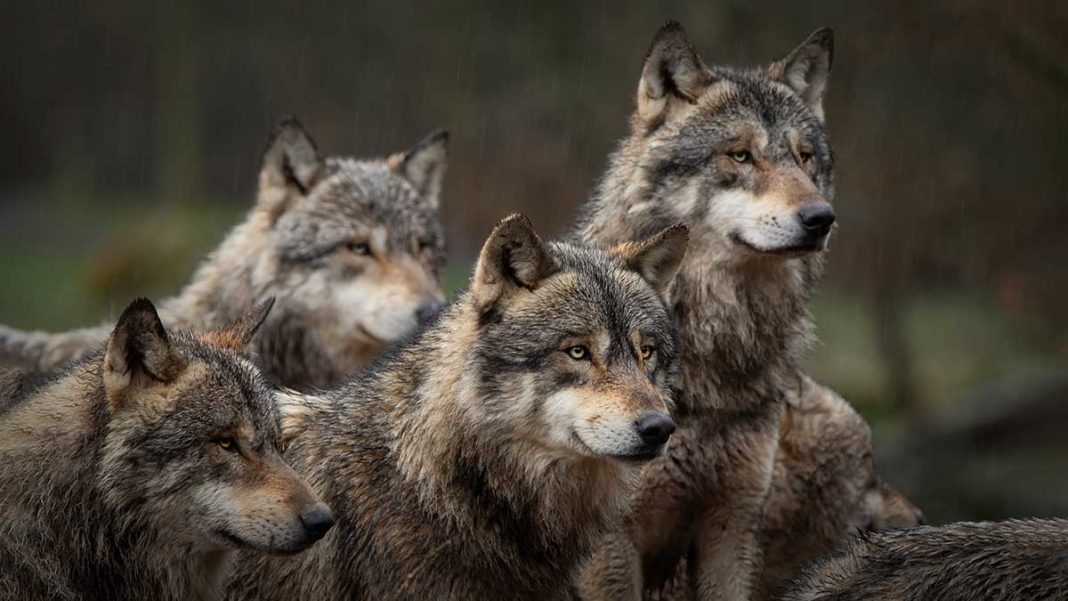MANITOULIN – The Manitoulin Nature Club was established in 1979 to increase knowledge of nature for its members and to support the preservation of elements of natural history, many of which are unique to Manitoulin. Members meet monthly to share observations and host guest speakers on topics of interest and recently had a look into the secret lives of wolves with a presentation by Thomas Gable, project lead on the Voyageurs Wolf Project. The project addresses the question, “what do wolves do during the summer in a forested ecosystem?”
“My family does have a cabin in McGregor Bay and that’s sort of like my special place,” said Mr. Gable. “I’m really jealous of all you who are in that area right now but I’m excited to talk about the work I’m doing here in northern Minnesota, because a lot of the things I’m going to talk about today translates into ecosystems like McGregor Bay, Killarney Park and Manitoulin Island where a lot of the habitats are very similar. We have very similar ecosystems where we have wolves hunting and killing deer and beavers primarily.”
Mr. Gable recently completed his Ph.D. at the University of Minnesota. He’s been studying wolves in the greater Voyageurs ecosystem since 2014, when he started his masters at Northern Michigan University. He’s particularly interested in wolf-beaver interactions and his graduate work was focused on trying to understand this predator-prey dynamic. Much of his early interest in wolves stemmed from encountering wolves, wolf tracks and occasional kills while exploring the wilds of places around his family’s McGregor Bay cabin. His research includes things not currently known about wolf hunting behaviour, wolf diet and how wolves impact larger ecosystems in the northern woods of Minnesota.
Voyageurs Wolf Project (VWP) is a University of Minnesota project that has been doing intensive wolf research for about seven years. It began in 2015, building on a monitoring program begun by Voyageurs National Park in 2012. Wolves in the Great Lakes region were removed from the endangered species list in 2012. “That triggered a lot of monitoring efforts by national agencies to understand how the delisting of wolves would impact the population,” he said.
The objective of VWP right now is to understand the reproductive ecology and predation habits of wolves in the summer in the greater Voyageurs ecosystem (reproductive ecology deals with raising pups). “With wolves you kind of have the season when they have their pups and there’s not snow and ice on the ground and then you have the winter, so summer and winter is how we really think about it,” Mr. Gable said.
During the summer, wolves are focused on two main things: having and raising pups and hunting and killing prey so they can feed themselves and provision their pups. To have a really detailed understanding of wolf ecology in the summertime, there needs to be a really detailed understanding of both of these facets of wolves, he explained. The VWP uses remote trail cameras and GPS collars to track the wolves.
Voyageurs National Park is located on the northern border of Minnesota. Canada is actually the northern border. The park is roughly 770 square kilometres and the VWP works in what they call the greater voyageurs ecosystem. A few wolf packs exist solely within the boundaries of the park but most have territories that border the park, with the wolves going in and outside of the park. Researchers needed to also understand what was going on south of the park if they wanted to understand wolves in the park because “borders don’t mean anything to wolves.”
One thing that makes the park unique is the abundance of beavers there. “It likely has the highest beaver densities in the lower 48 states and probably rivals even the highest densities in parts of Canada,” said Mr. Gable. One survey last winter identified 1,100 beaver lodges. “Compared to a place like McGregor Bay or Manitoulin Island, those would have substantially fewer beavers than we have here by a significant margin. Voyageurs National Park has a lot of mixed forest habitats and interspersed amongst those are a lot of wetlands and beaver ponds.”
During the summer, wolves are primarily hunting and killing small prey. In the project area and in places like Manitoulin and McGregor Bay, they’re killing beavers and deer fawns. “In the dense forest it’s difficult to observe where the wolf is killing and then consuming their prey, so it makes it really difficult to find what’s going on. Because of that there’s a lot of basic information about wolves that no one knows,” Mr. Gable said.
Before VWP started there were no estimates in scientific literature on how many fawns and beavers a typical wolf kills in the summertime, despite hundreds of thousands of hours of wolf research in places like Minnesota, Wisconsin, Michigan, Ontario, Quebec and Manitoba. “Because we don’t know really how many fawns and beavers a wolf is killing, we don’t understand what effect wolves are having on prey populations during these periods. It’s really hard to know how wolves might be impacting the beaver population if you don’t know how many beavers,” he said.
They’ve found that the typical wolf in the project area is killing between 13 and 15 deer fawns and 12 to 14 beavers in the summertime but there’s a wide range. “We’ve had one that killed only one beaver and last year we had a wolf that was sort of a beaver specialist and killed 42 beavers. To put 42 beavers into perspective, a typical beaver colony in our area has five beavers so that means that one wolf by itself killed eight-and-one-half colonies of beavers which is quite astounding.”
One key finding to date is that wolf diets are very flexible, meaning that wolves are very adaptable. They’re very good at finding unique food sources and taking advantage of them. Wolves kill and eat adult deer in the shoulder seasons of early spring and late fall. They hunt and kill freshwater fish for a couple of weeks in the springtime. The VWP was first to document that behaviour. VWP wolves all eat blueberries every summer without fail, with blueberries making up to 80 percent of their weekly diet during the month of July. “Berries are probably a starvation food source where in the summertime wolves are struggling to find calories, particularly the middle of summer. Blueberries don’t require a lot of energy expenditure and it sort of satiates them for a period of time,” explained Mr. Gable.
Wolves were previously thought of as cursorial predators that “primarily kill their prey by outrunning and outlasting it so they are not using a lot of secrecy or tactics, just brute force,” Mr. Gable said. VWP found that wolves hunt beavers by ambushing them, “which changed the way we think about wolves’ predation behaviour. Most predators have one main mode by which they hunt and kill their prey but wolves have the ability to go back and forth between two different hunting modes. That again speaks to their adaptability and probably is the reason wolves are able to exist in a variety of different habitat types.”
One of their most significant documented findings is how wolves actually alter wetland ecosystems. “Wolves impact wetland creation through a very simple, straightforward process. Wolves prey on beavers. Beavers create wetlands. By default, wolves impact wetlands by preying on beavers,” he said.
They found that wolves are impacting the creation of 88 ponds or wetlands in the Voyageurs area. “That is really just a drop in the bucket when you look at the ecosystem but when you look at this over multiple years then the impact becomes more substantial. If in year one wolves impact the creation of 88 ponds then the next year 88 ponds then the next and the next, then all of a sudden wolves are responsible for impacting the creation of over 400 ponds or wetlands,” Mr. Gable continued.
“Another way to think about it is when a beaver creates a single pond in a localized area it radically transforms that area from forests or meadow into a thriving wetland that’s doing all sorts of things like nutrient cycling, carbon storage, water storage, and providing habitats. Wolves that prevent that habitat from forming are then connected to all of these wonderful ecological processes that beaver ponds are responsible for. What we’ve been able to document is that wolves are very connected to wetlands, streams and riparian habitats. It’s such a simple process; all they have to do is kill a young beaver.”
There are still a lot of really interesting questions to be answered, Mr. Gable said. You can follow the Voyageurs Wolf Project on and other social media sites.






